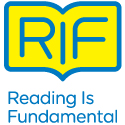The Reading Bond
2014
Samantha Vamos — RIF friend, children’s picture book author, and parent — guest blogs about the bond reading creates between parent and child.
 As a parent and children’s picture book author, I read children’s books every day. I read picture books and chapter books to improve my writing and keep current with what is being published, but also because I truly enjoy reading them. Most importantly, however, I read because of the bond that reading has created with my son.
As a parent and children’s picture book author, I read children’s books every day. I read picture books and chapter books to improve my writing and keep current with what is being published, but also because I truly enjoy reading them. Most importantly, however, I read because of the bond that reading has created with my son.
From the beginning of his life, words have enveloped him. While he was in my belly and merely a few weeks from birth, I sometimes read aloud to him. When I read silently to myself, I imagined the words swirling around my brain flowing through my blood stream and into his, our lives connected. After he was born, when he was only a few days old, it didn’t matter to me if I read a children’s book or my husband read The New Yorker or Sports Illustrated to our son. I just wanted him to hear our voices articulating words over and over again.
My son is now seven and although he reads books on his own, we continue to read together each day. Reading to and with my son is one of my favorite rituals and a simple pleasure we share. I look forward to the moment when we become immersed in a story, his attention fully engaged. My playful, active son winds down, enticed by hearing about a farmer who photographs snow crystals, finding no two alike; a princess who uses her intellect to defeat a fire-breathing dragon; “star-bellied Sneetches” and “plain-bellied Sneetches”; a cane-carrying mouse that retrieves his mother’s wedding ring from a bathtub drain; the friendship between a librarian and a library lion; a farm maiden, farmer, and five farm animals that stir a pot and create a surprise recipe together*; and so much more. The characters, topics, and plots are endless; invariably, comment or discussion ensues. My son often asks the meaning of words, and I hear him incorporate new words learned into his speech. A broad vocabulary helps him understand new and complex concepts and ideas.
Listening to stories contributes to the development of his imagination—life is so much richer when enhanced by creativity. Reading has also built his attention span and that’s a skill necessary for learning. At its core, reading is an opportunity for us to connect over words spoken and emotions evoked. Sometimes, in relation to a story, my son explores feelings or tells me something that occurred at school. I listen carefully, grateful that hearing a story resulted in unexpected revelations and disclosure.
Where do we read? Everywhere. My husband and I take turns reading to our son during part of meals. In his bedroom, we cozy up in a chair that I have deemed “our reading chair.” We read before sleep, on airplanes, and on the occasional bus trip. When we’re out for an excursion, I typically wear a backpack allowing me to carry not only crayons and paper but also a book. One afternoon as we waited for pizza at a restaurant, I began reading a book. When my son noticed a young girl in the booth next to us straining to hear, he urged, “Read louder, Mommy.” I did and shortly thereafter, with her parent’s encouragement, the young girl temporarily joined us in order to better see the illustrations. The company delighted my son. With two pages remaining, our pizza finally arrived, yet neither child lifted as much as a finger, preferring to wait to hear the story’s end.
Books in our home come from both libraries and stores. We visit the library almost every week—we typically have between five and fifteen library books scattered throughout our home. At the age of four and a half, my son was as overjoyed about obtaining his own library card as he was about receiving a new Thomas the Tank Engine train for his birthday. In fact, his excitement about the library card lasted far longer. The card is attached to a small, bungee cord; for quite some time, he proudly showed it to all his teachers and anyone who visited our home. Of course, the card was a sign of his independence and that held special meaning for him. He can select books all by himself and his pride is evident when a book he chooses turns out to be one we especially like.
When we discover a book we love, we record the title as a reminder to purchase it. We celebrate with books as gifts for most if not all holidays. In our home, our son understands that Santa Claus, Cupid (for Valentine’s Day), the Easter Bunny, and the Tooth Fairy all appreciate written requests for books (which has turned into terrific opportunities to practice writing). That is not to imply that toys, chocolate, jelly beans, or money are excluded from the latter-mentioned holidays, but books are important and included.
Birthdays are occasions for books as well. On my son’s first birthday, I began a tradition I intend to uphold all his life. In addition to other gifts, I give him a book. Although the books I’ve selected are not necessarily age-appropriate, they are books I want him to have in his personal collection. On his first birthday, he received “The Little Prince,” by Antoine de Saint-Exupéry. On his second birthday, I selected a childhood favorite of mine: “Where the Sidewalk Ends,” featuring the poems and drawings of Shel Silverstein. For his third and fourth birthdays, respectively, he received Harper Lee’s “To Kill A Mockingbird” and a hardback version of Brian Selznick’s highly illustrated novel, “The Invention of Hugo Cabret.” For his fifth birthday, I gave him L. Frank Baum’s “The Wonderful Wizard of Oz: 100thAnniversary Edition.” For his sixth birthday, he received a box set of the seven paperback volumes of J.K. Rowling’s “Harry Potter” series. I inscribe each book with a note and the specific birthday that the book commemorates; then, I store the book in our son’s bookcase or on one of my bookshelves.
Even when my son enjoys reading on his own, I will continue to look for stories to read and share with him. I want to foster our reading bond as long as possible. My mother not only read chapter books to me when I was reading on my own but also created individual stories for my sister and me. Before bedtime, my mother sat by my sister’s bed and, later, mine in order to share chapter installments. My sister’s story featured a ladybug and her children. My story concerned the adventures of a miniature fairy. Closing my eyes, listening to my mother’s soft voice, I imagined the fairy and her exploits. After school, homework, dinner, and chores, hearing a story before falling asleep was a soothing, gentle way to enter the night. I cherish those memories and I know that experience sparked a desire that later grew into a passion. I began to dream about becoming an author. Eventually, I wrote stories and, many years later, I published one of them.
Now, when at school or library presentations for my children’s picture books, I enjoy telling children that I composed my first story at the age of three. For a few seconds, eyes widen in amazement until I clarify what really happened. At that age, my mother encouraged me to make up stories and tell them to her. Without influencing subject, grammar, or length, she typed the stories exactly as I told them. My first story, “The Red Hen” (circa 1967), is only several lines and rife with grammatical errors, yet the freedom to create, uninterrupted by correction, allowed my thoughts to flow. My confidence as a beginning storyteller began to build.
I have similarly encouraged my son to practice storytelling. His first, formal attempt is titled “The Run Away Coconut” and consists of nine sentences. Whether storytelling becomes his passion is not important to me. I just want him to experience the process in a pleasurable, relaxed way just as he enjoys our reading together.
While I find our reading “connection” to be gratifying in and of itself, I also know that reading each day produces a substantial gift – that of literacy. It is well established that children who are read to are more likely to read earlier, stay in school, succeed in school, and pursue higher education, which has its own benefits and rewards.
As parents and caregivers, we are in a unique position to promote and support literacy. As I read with my child, I know I’m giving both him and myself intangible, lifelong gifts – a unique literary bond with memories that may be refreshed each time he reads a certain story; an aptitude for and interest in reading; and, most importantly, the knowledge that he can and will succeed – in school and, I believe, elsewhere in life.
Samantha R. Vamos is author of the 2010 Washington State Book Award Winner, Before You Were Here, Mi Amor (Viking Children’s Books, 2009, illustrated by Santiago Cohen) describing all the things one family does to welcome a new child into the world; The Cazuela That The Farm Maiden Stirred (Charlesbridge, February 1, 2011, illustrated by Rafael López) – a “House That Jack Built”– inspired tale in which five farm animals each contribute ingredients to the cazuela (“pot”) that the farm maiden stirs, and Alphabet Trucks (Charlesbridge, Fall 2013), a rhyming, alphabet book about twenty-six different trucks and how they serve their communities. http://www.samanthavamos.com
*The Paper Bag Princess by Robert Munsch, illustrations by Michael Martchenko (Annick Press, 1980); Snowflake Bentley by Jacqueline Briggs Martin, illustrations by Mary Azarian (Houghton Mifflin Company, 1998); The Sneetches and Other Stories by Dr. Seuss (Random House, 1961); Stuart Little by E.B. White (Harper Trophy, 1945); Library Lion by Michelle Knudsen, illustrations by Kevin Hawkes (Candlewick, 2006); and The Cazuela That The Farm Maiden Stirred by Samantha R. Vamos with illustrations by Rafael López (Charlesbridge, February 1, 2011).



Follow Us